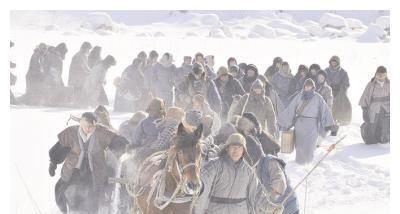In 2008, a TV series called "Breaking into Guandong" appeared on the screen, which was unanimously praised by the audience, telling the story of a simple Shandong family who came to Kanto to beg for a living, and suffered various tribulations on the Kanto Road, historically, the phenomenon of breaking into the Kanto can be said to have been around for a long time, Shanhaiguan as the boundary, delineating the Guanwai and the Central Plains, from the Qing Dynasty Shunzhi Emperor years, there have been people going to Guanwai to seek their own livelihood.

This also makes people curious, according to the reason, although the land materials in the northeast are fertile, but the climate is too cold, why do Shandong people not go to the warmer south when they break into the Kanto? In fact, if we combine historical factors, we can understand a general reason.
China is a traditional farming civilization, so the rich land in people's eyes, it is particularly important, but with the Qing army into the customs, the northeast of this land gradually became strange, the Qing Dynasty in the late 17th century, in the northeast of the new dike trench, ai Xin Jue Luo family believes that the northeast is "the ancestral traces of the king's place", "the land of longxing", so the Han people are not allowed to enter.
With the closure of the enclosure, the hoarded wild resources here have gradually recovered, and there are still many Han people who secretly cross the wicker edge to reclaim wasteland or go into the mountains to hunt, except for the Qianlong Emperor who took strict measures to crack down on these people, the rest of the Qing Emperor turned a blind eye to this.
After 1840, with the signing of wars and unequal treaties, in order to increase the tax revenue of the imperial court, the Qing royal family was forced to lift the ban and allow ordinary people to freely enter and leave the area outside the customs. From 1861 to 1911, the government's control over the frontier was further weakened, and the Tsarist Russia continued to encroach on the border of Heilongjiang, prompting further reforms by Qing policymakers.
In the 19th century, the lower reaches of the Yellow River in China were repeatedly affected, and Shandong Province, in particular, became a hard-hit area, either a major drought or a major flood, so many Shandong people lost their homes and could only leave their hometowns and go to other places. For the people of Shandong, although the south is rich, it is not a good place to go, first of all, it is too densely populated, and agricultural resources have long been distributed.
Many peasants in the north, in addition to cultivating land, have no other skills, and secondly, the dialect of the south is more obscure than that of the north, and it is not convenient to communicate in language.
The road to the Kanto can be taken by boat or by dry road, and the later Qing government in order to encourage the reclamation of wasteland, even has a special boat to guide, so the Kanto has also become the best choice for Shandong people.
Therefore, in the early 19th century, when the Qing government still had a closed policy, countless bankrupt peasants could not ignore the ban and risked being punished and entered the Kanto. According to the data, in 1910, the qing dynasty collapsed and migrated, the population of the Kwantung has grown to 18 million, and during the Republic of China, this number was further expanded, reaching 40 million people, just in the 38 years of the Republic of China, the number of Shandong people breaking through the customs every year was 480,000 people, about half of the total population of the Kanto.
It can be said that breaking into the Kanto has also become one of the largest population movements in the modern history of the world, an unprecedented move in Chinese history, and it also symbolizes the Chinese nation's courage to explore, perseverance and pursuit, and the most simple and unpretentious love for the land.